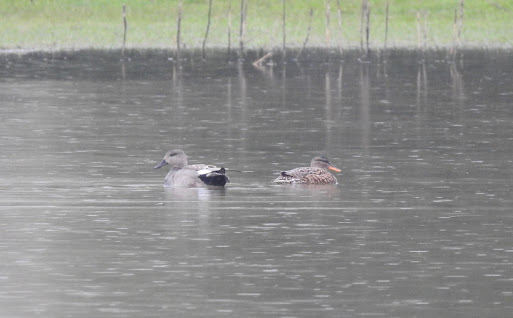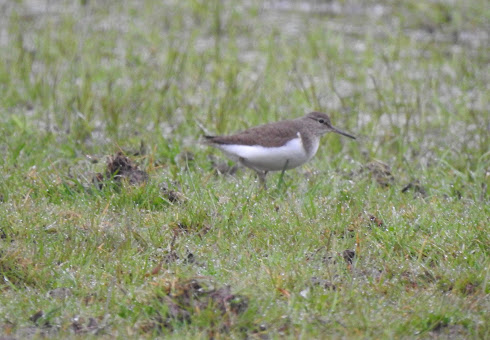I suspect a lot of birders know this one. It is tempting to predict a particular species you are going to see (and I don't mean Robin), you just cannot help yourself. I try to steer clear of this game because the second I say Bar-tailed Godwit, or Hoopoe, or Bee-eater I know that even if the country is full of them, I won't see one.
No, the best game is to try to pick a day when "its all happening". Because its true that a particularly grotty day at the end of April, or a day of strong north-easterlies on the east coast should produce good birding.
Yesterday, the local social media was in a bit of a frenzy. Today would be the day.
It wasn't.
The rain arrived maybe a little too late, just after dawn. By the time I emerged, cocooned against the deluge, the results were starting to seep in. Nothing at Bittell. No change at Earlswood. I rolled the dice and went to Mappleborough Green Flash. Where better than a large puddle just beyond the Redditch frontier to find something good?
As a matter of fact I had two Mappleborough Green Flash ticks, but I should point out its a very low bar. The first was a pair of Gadwall. Woohoo. I wasn't completely sure I hadn't seen one there before, but it was a Birdtrack write-in, so I can't have.
 |
| Gadwalls in the rain |
All was not lost. The second tick was a wader, and a year tick, and it showed well. A Common Sandpiper. There was one last year, but I dipped. Pay back time.
 |
| Common Sandpiper |
Living the dream!
My reason for visiting Mappleborough Green ahead of Morton Bagot is wader habitat. Map has it, Morton B doesn't (yet). I also saw three Little Ringed Plovers, and a Lapwing. So that was two more waders than I was due to find at my "proper" patch.
But Morton Bagot is not all about waders, fortunately. As I arrived there, the rain was starting to ease, and the wind was very light. True, it was blooming cold, but could this be the day for a fall of passerines?
Well not exactly, but it wasn't bad. It's just a shame that they were all hiding away, singing from dense bushes or impenetrable rushy areas. The best find was a Grasshopper Warbler. Now we're talking. It was singing from somewhere in the Chat Field, possibly. I thought about devoting half an hour to trying to pin it down, but that would be wasting valuable wader finding time, so I made a mental note to check it out later....when it had stopped singing (good plan).
Also singing out were Lesser Whitethroat (probably two), and Sedge Warbler (definitely two). But they didn't show. I got to the flash field to find no Avocets. Instead there was a Little Egret, 14 Teal, and four Lapwings. At least the cold damp weather had dropped a few (nine) Swallows and three House Martins down to eye-level.
Continuing along the brook I wasn't surprised to find the Wheatears had gone (no one likes being woken up in the night, then weighed and measured, even for some new bling). I ventured into Stapenhill Wood where several Chiffchaffs and Blackcaps flicked about, and I eventually found a rather nice Willow Warbler. The almost obligatory Red Kites flew over.
Arguably my best find came in the ridge field where I photographed a dot on a distant sapling suspecting correctly that it was a Stonechat. The first since early March, it soon disappeared but could mean we'll have some fledglings later this spring.
My second attempt to hear/see the Grasshopper Warbler did have one happy consequence. A Common Whitethroat piped up from a dense blackthorn, my third year-tick of the day. It largely remained out of sight.
Back at Netherstead with no decent photos for the blog I pointed my camera at the pair of Tufted Ducks I first saw last week.
 |
| Tufted Ducks |
Just a fortnight to the all-dayer, I need these guys to stay.
No comments:
Post a Comment